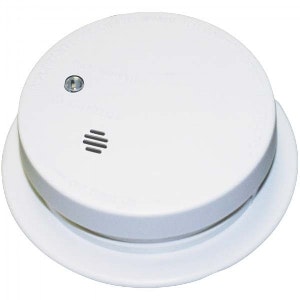Smoke Alarms

SMOKE ALARMS, ALSO CALLED SMOKE DETECTORS, ARE REQUIRED BY CALIFORNIA STATE LAW (HEALTH AND SAFETY CODE) IN ALL HOMES AND APARTMENT UNITS. MOST OLDER ALARMS ARE BATTERY POWERED. SOME ALARMS ARE POWERED BY HOUSE CURRENT, WHILE THE NEWEST ALARMS GET THEIR ELECTRICITY BOTH FROM THE BUILDING WIRING AND A BACKUP BATTERY.
According to NFPA, aging smoke alarms don't operate as efficiently and often are the source for nuisance alarms. Older smoke alarms are estimated to have a 30% probability of failure within the first 10 years. Newer smoke alarms do better, but should be replaced after 10 years. Unless you know that the smoke alarms are new, replacing them when moving into a new residence is also recommended by NFPA.
Smoke alarms, when properly installed, give an early audible warning needed to safely escape from fire. That's critical because 85% of all fire deaths occur in the home, and the majority occur at night when most people are sleeping. Last year, NFPA documented 3,420 home fire deaths.
Fully 94% of U.S. homes had at least one smoke alarm as of 1997, according to NFPA, but as of 1998, 40% of the home fires reported to U.S. fire departments and 52% of home fire deaths still occurred in the small share of homes with no smoke alarms. Half of the deaths from fires in homes equipped with smoke alarms resulted from fires in which the smoke alarm did not sound--usually when batteries were dead, disconnected or missing. "Simple steps like maintaining smoke alarms and replacing older ones help diminish the possibility of fire deaths in the home," says John R. Hall, Jr., NFPA's assistant vice president for fire analysis and research. "Smoke alarms in the home are largely responsible for the decreasing number of home fire deaths over the last decades."
El Dorado County Smoke Alarm/Carbon Monoxide Requirements
New Requirements for Smoke Alarms - updated 02/12/15
Types of Smoke Alarms
There are two types of smoke alarms (photo-electric and ionization); each type has its advantages and disadvantages. If you are experiencing nuisance alarms (from cooking, etc.), changing the type of smoke alarm could reduce the number of these alarms.
Placement of Smoke Alarms
Smoke alarms are intended to notify people of an impending fire where they sleep. Smoke alarms should not be installed in garages or in the kitchen, since this will surely result in nuisance alarms.
Smoke alarms should be installed in each sleeping room, and in the room or hallway leading to the sleeping room. The device may be installed anywhere on the ceiling but at least 6 inches from the wall. Alarms also may be installed high on the wall, within 6 inches and 12 inches of the ceiling.
In dwellings built after the mid-1990s, all smoke alarms are interconnected electrically. When one alarm senses smoke, it causes all the alarms to sound.
What to do if a smoke alarm sounds
You should assume that the sound from a smoke alarm is informing you of a fire. Investigate the source of the smoke. If there is a fire, leave your house or apartment immediately, find a phone and call 9-1-1.
If there is smoke but no hostile fire, eliminate the source of the smoke, then "fan" the alarm to purge it of smoke. Some alarms have a temporary silence or "hush" button, which can be pushed to reduce the sensitivity of the device for about 5 minutes. Do NOT remove the alarm battery to stop the alarm.
Alarms will "chirp" every 30 seconds or so when the battery is almost dead. This sound will persist for several days. When you hear this chirp, change your to battery. Better yet, change the batteries twice a year. This way, you will never hear the low battery signal!
Additional Information
How do I change a smoke detector battery?
